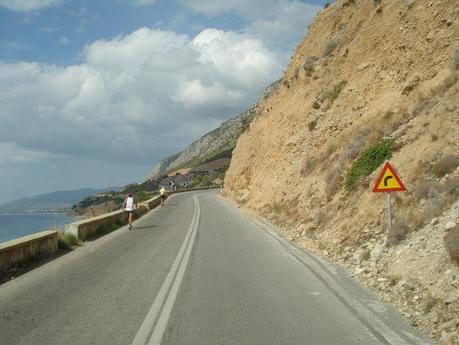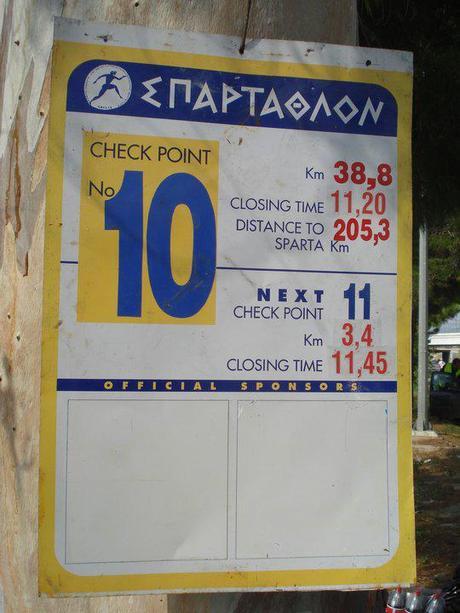My experience of this race is fairly insignificant in comparison to lots of people you will meet out there. I have started twice and finished twice and though my authority on such a race would be negligible in comparison to those who may have finished ten times (or even DNF’ed a lot too) I figure I at least have something to say.
This is more some thoughts for the race day. It’s not a “training guide”, I assume that everyone at the start line is capable of running 153 miles.
This is a very simple race, it’s just a lot of miles on road. It does not claim to be the longest, hottest, hilliest, highest, coldest, wettest or deadliest out there but based on lots of reports from ultra-runners who have done all the races making these claims the Spartathlon certainly ranks up there with the hardest races in the world.

The cut-off for the first marathon is 4.45. Unless you are planning on winning you really should not be more than an hour inside this time at this stage. The problem is you get here and say “shit – I am only half an hour inside the cut-off, I must now run like hell to get more time for the 50 mile cut-off”. This leads to many runners just burning out in the first 50 and having not a lot left for the small matter of the last 103 miles.
The cut-off for the 50 mile stage is 9.30, which itself is quite fast and beyond many people on it’s own. If the times were divided evenly for the whole 153 then this cut-off should be something like 11.45. I think the reason is to get people off the busy roads and into the countryside before it gets too late and dark. You don’t need to be way ahead of the cut-offs at this stage, there is plenty of time in the next 50 to chip away at them.
The first year I did this I got to the 50 in 7.37, the fastest 50 miles I have ever done. Though I felt quite good at the time I was made to pay for this speed later on as my body fell apart, particularly in the last 50. The next year I did it I got there in about 8.30, nearly an hour slower but I was in so much better shape physically that I ended up finishing over 2 hours quicker.
So in summary, don’t run like an idiot.
Anyway, I laboured the above quite a bit as I believe based on being in this race twice that what I have described is the single biggest reason of DNFing, not the cut-offs themselves but the panic they create. DON’T PANIC.
One more thing. Don’t obsess about your times from checkpoint to checkpoint. All of the 75 checkpoints have displays saying when it closes and this means that you can calculate easily how far you are ahead of the cull. It also means that you will be able to rate each section in terms of how much time you have gained or lost. My advice would be not to do this as it really messes with your head. I realise this is like saying “Don’t think about polar bears”. Just don’t look at your watch every time.
The Race
First 50
Be careful at the start. From the Acropolis it is downhill on cobbles and in a crowd. You certainly do not want to twist an ankle with 152.9 miles to go, that would hurt a lot.
The first few miles are through the busy streets of Athens but the police do a fantastic job of stopping the traffic so that the runners can pass through. Most road crossings will have the police there to stop traffic and wave you across. The first two checkpoints are pretty far apart.
Once you are out of the centre of Athens you are treated to some quite ugly industrial parks and refineries and such. As the day warms up this can get a bit suffocating. After about 40 miles you are running along the coast and this is lovely, a couple of inclines in there. The 2 miles before the first major checkpoint at Hellas is another busy grim road but after that it’s lovely.
I’d say don’t spend too long at Hellas Can though I always do. There are lots of places to sit, there are usually at least 30 runners and their supporters there hanging around eating and resting. You will find the atmosphere change immediately here, from busy roads to really quiet and windy paths through olive fields.
If you can stick with the Brazilian runners, their support teams are a very nice visual distraction : )
The second 50
From 80-115k are gently uphill so don’t worry too much about slowing down, remember that the cut-off you have just made for 50 was quite tight and now they ease up a bit. As the sun sets you’ll pass through some lovely little villages where the people really come out and support. I recommend eating the proper food they put on (rice, soup etc) as the food in this race is generally really bad, dry biscuits and fruit.
There will be kids asking for autographs. Sign then it will make you feel better. Not all of them though there can be quite a lot. Maybe get a stamp or do what Wayne Rooney does and just put an “X”.
It gets dark at seven, exactly 12 hours after the start (it is this that allowed Heroditus to estimate that it took Phiddipides 36 hours to complete this, from sunrise to sunset the next day). It goes down quickly behind the mountains that will now surround you. Be ready with your lights and stuff as it gets very dark.
It can get windy and cold too (and rain is very common too). Bin Bags are very effective for keep the rain out and giving a little warmth while being disposable. Consider putting them in each of your drop bags as they were few and far between last year.
There is a section along a dirt path. If it rains this becomes quite hard but otherwise the path is very good.
Shortly before the mountain there are about 2 miles of slow slogging uphill. I find this is a perfect opportunity to walk, eat, drink coffee etc. Consider leaving some food in a drop bag in CP 46.
CP47 (MOUNTAIN BASE) is brilliant, particularly if you are British. This is run by a team of Brits who go crazy when they see a fellow countryman. There are beds where you can have a massage (or sleep but I would not recommend that).

This is one of most wonderful parts of any race I have ever done. It’s up there with the left turn on the canal or the McDonalds in Lone Pine or Washington Bridge. Take your time and enjoy.
It is a scramble to get up the thing but having pounded your legs on 100 miles of road it actually can feel like a break. It is so well lit up you can’t go wrong. It gets cold at the top though but I recommend just taking a minute to look behind you at what you have done. The villages are still lit up with the action of the race.
Be careful going down. I ruined myself the first year, it really hurt. The path down is quite easy but in the dark and with 100 miles in you it’s easy to trip over. Inevitably you might find that both up and down there is a lot of overtaking, you may pass people or they may pass you. Don’t think too much about this, the mountain goats will obviously fly up the hill faster but they might be slow on the road again. I always lose positions on the mountain (first year I lost about 40, second year I think just 2).
The Last 50ish
After the downhill things are generally up again. It’s similar to the second 50 except towards the end the road gets very busy. Try not to sit down especially now as it’s so hard to get back up again. At this stage you may start losing time on the cut-offs but try not to think about this too much if you are sufficiently ahead.
Not much more to say other than the finish is pretty special : )
Drop Bags and Carrying stuff
Most important thing to remember here is to do your own thing. First year I did this I only intended on having 5 drop bags but saw others putting 20 or more down. On seeing this I thought “I must be wrong then” and at the last minute changed my mind and had 20 drop bags. Come the race I hardly touched most of them and got confused as to where they were. The following year I only had 5 and that worked perfectly (apart from my own error of not putting the head lights early enough).
Do your own thing and don’t change it at the last minute just because others are doing differently. DON’T PANIC
I carried a bottle belt with small storage space last year which worked well for me. Some reports say it’s unnecessary to carry such things but it is a matter of personal preference. You don’t need to carry much water as there is lots along the way but I did like having something to carry my phone, electrolytes and lube in. I’d say about half the runners there will carry something like this with them.
Try to clearly mark your drop bags. The people on the stations are generally very good at spotting you and handing you your bag. Also be prepared not to get stuff back. Again they are very good at returning stuff generally but sometimes labels come off or things fall out. Everything that is picked up in the race will go back to Athens where you collect your things and if it not marked it will be in a miscellaneous pile.
I don’t really have much to say on what to put in the bags. If you have specific food requirements (remember the food is not very good in the race) then you may need lots of drop bags. You will obviously need lights at night, also another layer for the night as it does get cold. Waterproofs depending on the forecast (or bin bags). I have put another pair of shoes in just after the mountain both years I have done it and that worked well. Socks are a good idea too especially if it will rain.
Spare hats/shades/suncream etc for the next day. I forgot a hat last year but luckily there was no sun. In the event of sun I was going to trade my head torch for a hat with some kid but it never came to that.
Right, only a week to go so I will finally publish this. I soooo want to run this year but will probably not. Enjoy.
Some race reports
Rune Larsson "How to run the Spartathlon"
John Foden "Time spent at refreshment stations"
John Tyszkiewicz
Brits Newsletter 2010
Brits Newsletter 2009

posted on 13 September at 13:07
Thank you~ what a great article to describe your experience. I am going to participate 2012 Spartathlon. This will be a great help to me!